Rocks
Rocks are all around us. They make up the backbones of hills and mountains and the foundations of plains and valleys. Beneath the soil you walk on and the deep layers of soft mud that cover the ocean basins is a basement of hard rock.
What are rocks made of?
Rocks are made up mostly of crystals of different kinds of minerals, or broken pieces of crystals, or broken pieces of rocks. Some rocks are made of the shells of once-living animals, or of compressed pieces of plants.
We can learn something about the way a rock formed from by looking carefully at the evidence preserved inside. What a rock is made of, the shapes of the grains or crystals within the rock, and how the grains or crystals fit together all provide valuable clues to help us unlock the rock's history hidden within.
Where do rocks come from?
Rocks are divided into three basic types, igneous, sedimentary and metamorphic , depending upon how they were formed. Plate tectonics provides an explanation for how rocks are recycled from igneous to sedimentary to metamorphic and back to igneous again.
 Igneous rocks
Igneous rocks
Igneous rocks (from the Greek word for fire) form from when hot, molten rock (magma) crystallizes and solidifies. The melt originates deep within the Earth near active plate boundaries or hot spots, then rises toward the surface. Igneous rocks are divided into two groups, intrusive or extrusive, depending upon where the molten rock solidifies.
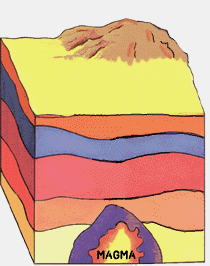 Extrusive igneous rock
Extrusive igneous rock
Extrusive , or volcanic, igneous rock is produced when magma exits and cools outside of, or very near the Earth's surface. These are the rocks that form at erupting volcanoes and oozing fissures. The magma, called lava when molten rock erupts on the surface, cools and solidifies almost instantly when it is exposed to the relatively cool temperature of the atmosphere.
Quick cooling means that mineral crystals don't have much time to grow, so these rocks have a very fine-grained or even glassy texture. Hot gas bubbles are often trapped in the quenched lava, forming a bubbly, vesicular texture.
Example: Basalt
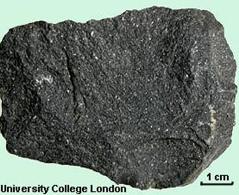
Intrusive igneous rock
Intrusive, or plutonic igneous rock forms when magma is trapped deep inside the Earth. Great globs of molten rock rise toward the surface. Some of the magma may feed volcanoes on the Earth's surface, but most remains trapped below, where it cools very slowly over many thousands or millions of years until it solidifies. Slow cooling means the individual mineral grains have a very long time to grow, so they grow to a relatively large size. Intrusive rocks have a coarse grained texture.
Example: Granite
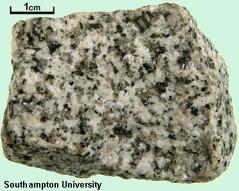 Metamorphic rocks
Metamorphic rocks
Metamorphic rocks started out as some other type of rock, but have been substantially changed from their original igneous, sedimentary, or earlier metamorphic form. Metamorphic rocks form when rocks are subjected to high heat, high pressure, hot, mineral-rich fluids or, more commonly, some combination of these factors. Conditions like these are found deep within the Earth or where tectonic plates meet.
In metamorphic rocks some or all of the minerals in the original rock are replaced, atom by atom, to form new minerals.
Metamorphic rocks are often squished, smeared out, and folded. Despite these uncomfortable conditions, metamorphic rocks do not get hot enough to melt, or they would become igneous rocks!
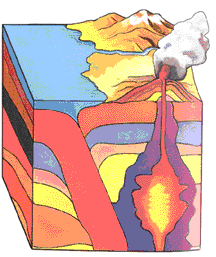 Sedimentary rocks
Sedimentary rocks
Sedimentary rocks are formed from pre-existing rocks or pieces of once-living organisms. They form from deposits that accumulate on the Earth's surface. Sedimentary rocks often have distinctive layering or bedding.
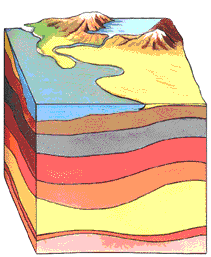 The Cache
The Cache
To claim is found, first you have to go to the given coordinates that are in a place of senic view in the middle of the rocks and send me an email with the correct answers to the following questions:
- What is the name of the igneous rock that is all around you and what are its main components?
- Lean back while enjoying the scenery, what is the height of the rock (in meters) that is behind your back?
After receive my mail validating your answers, you must upload a picture to your log, a picture of the senic view. It is not necessary to see your face or the GPS.
A Cache
Para reclamar o found tem primeiro que ir até as coordenadas indicadas que são de um miradouro no meio das rochas e enviar-me um e-mail com respostas correctas às seguintes questões:
- Qual o nome da
rocha ígnea que observa a sua volta e quais são os seus principais componentes?
- Encoste-se enquanto aprecia a paisagem, qual a altura da rocha (em metros) a que está encostado ?
De pois de receber o meu mail, logue o found e coloque uma foto que mostre a paisagem que se avista do local. Não é necessário que se vejam as faces de ninguém nem o GPS.

